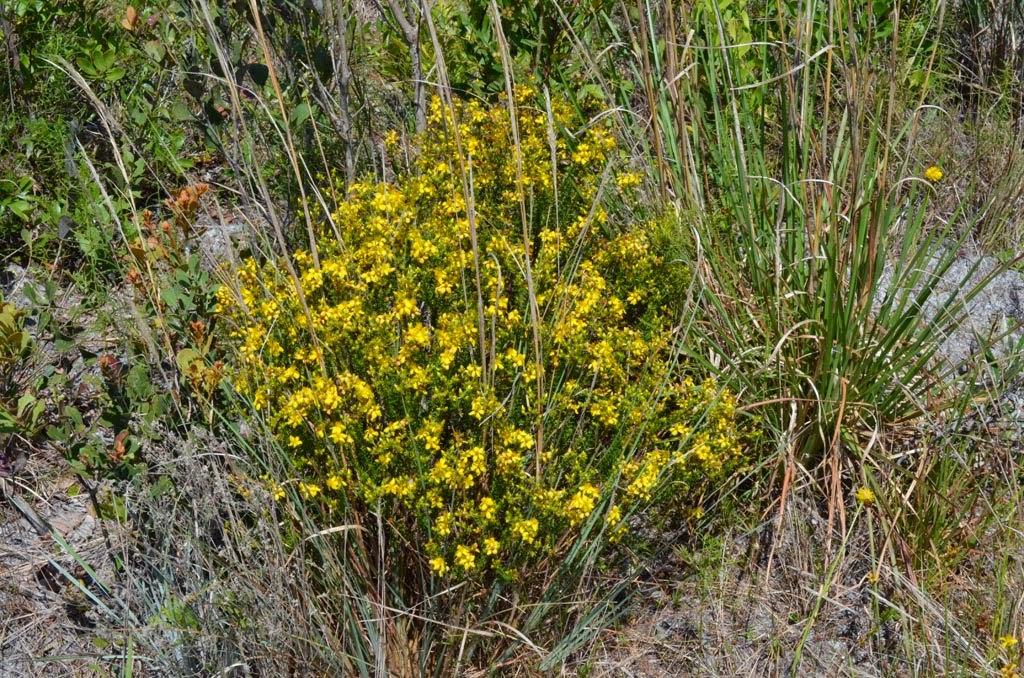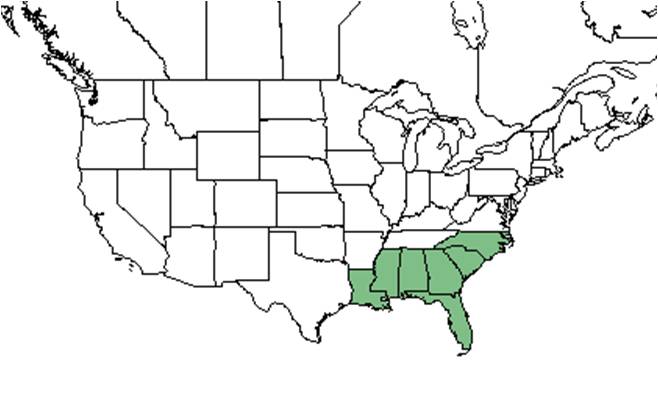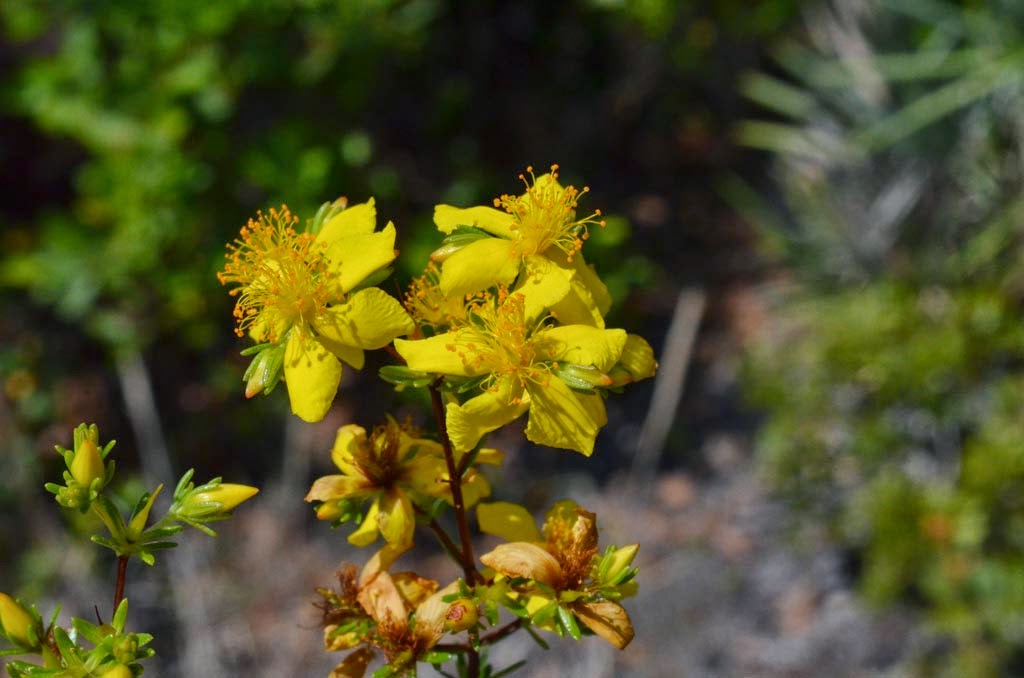Hypericum fasciculatum
| Hypericum fasciculatum | |
|---|---|

| |
| Photo by Wayne Matchett, SpaceCoastWildflowers.com | |
| Scientific classification | |
| Kingdom: | Plantae |
| Division: | Magnoliophyta - Flowering plants |
| Class: | Magnoliopsida - Dicotyledons |
| Order: | Theales |
| Family: | Clusiaceae ⁄ Guttiferae |
| Genus: | Hypericum |
| Species: | H. fasciculatum |
| Binomial name | |
| Hypericum fasciculatum Lam. | |

| |
| Natural range of Hypericum fasciculatum from USDA NRCS Plants Database. | |
Common name: Peelbark St. Johnswort
Contents
Taxonomic notes
Synonyms: none.[1]
Varieties: none.[1]
Description
H. fasciculatum is a short lived perennial that has a single stem with reddish bark and forms thin adventitious roots. It can be distinguished from similar species, such as H. brachyphyllum by having flat leaves with no apparent fold.[2]
“Usually glabrous herbs or shrubs. Leaves usually punctate, simple, opposite, entire, usually sessile or subsessile, exstipulate. Inflorescence basically cymose; flowers perfect, regular, bracteates, subsessile or short-pedicellate, sepals 2, 4, or 5, persistent; petals 4 or 5, usually marcescent, yellow or pink; stamens 5-numerous, separate or connate basally forming 3-5 clusters or fascicles, filaments usually persistent; carpels 2-5, stigmas and styles separate or fused, ovary superior, 1-locular or partly or wholly 2-5 locular, placentation axile or parietal. Capsules basically ovoid, longitudinally dehiscent, styles usually persistent; seeds numerous, lustrous, areolate, cylindric or oblong. In general our species form a polymorphic complex with many intergrading taxa.” [3]
"Erect shrub, 8-15 dm tall, much-branched above, spongy-thickened below. Leaves linear-subulate or linear, with 2 longitudinal grooves below, largest usually 13-26 mm long, 0.7-2 mm wide, acute, base notched, sessile. Flowers terminal and axillary, solitary or in cymules. Sepals 5, similar to the leaves, 3-7 mm long, usually more than 4.5 mm long; petals 5, 6-9 mm long; styles united or 3, usually separate in fruit, ovary 3-locular. Capsules ovoid, ca. 4.5 mm long and 2mm broad; mature seeds not seen." [3]
Distribution
This plant's range extends from eastern North Carolina to southern Florida, and west to southern Mississippi.[1]
Ecology
Habitat
In the Coastal Plain in Florida and Georgia, H. fasciculatum can occur in Nyssa/Ilex communities, dry pond margins, ditches in pine flatwoods, beaver ponds, titi bogs, rotted stumps, upland depression ponds, and dry bottoms of cypress ponds. [4] It responds to an annual, seasonal, or short-term change in water level by rapid colonization of favorable habitats and development of adventitious roots. [5] Associated species include Ilex myrtifolia, Eriocaulon lineare, Xyris, Rhynchospora corniculata, and Lycopodiella. It grows in moist loamy sand. [4]
Hypericum fasciculatum is an indicator species for the Peninsula Savannas community type as described in Carr et al. (2010).[6]
Phenology
H. fasciculatum has been observed flowering in February, April to July, October, and November with peak inflorescence in May.[4][7] It has been observed fruiting October through December.[4]
Pollination and use by animals
The following Hymenoptera species were observed visiting flowers of Hypericum fasciculatum at the Archbold Biological Station: [8]
Bees from the family Apidae: Apis mellifera, Bombus impatiens
Plasterer bees from the family Colletidae: Colletes nudus
Leafcutting bees from the family Megachilidae: Coelioxys sayi
Conservation, cultivation, and restoration
Cultural use
It contains volatile extracts primarily of composed of decyl acetate and gamma-muurolene, and has been used as cathartic agent in traditional Seminole Indian medicine. [9]
Photo Gallery
Flowers of Hypericum fasciculatum Photo by Wayne Matchett, SpaceCoastWildflowers.com
References and notes
- ↑ 1.0 1.1 1.2 Weakley, A.S. 2015. Flora of the southern and mid-atlantic states. Working Draft of 21 May 2015. University of North Carolina at Chapel Hill, Chapel Hill, North Carolina.
- ↑ [[1]] Accessed: January 5, 2016
- ↑ 3.0 3.1 Radford, Albert E., Harry E. Ahles, and C. Ritchie Bell. Manual of the Vascular Flora of the Carolinas. 1964, 1968. The University of North Carolina Press. 709-713. Print.
- ↑ 4.0 4.1 4.2 4.3 Florida State University Robert K. Godfrey Herbarium database. URL: http://herbarium.bio.fsu.edu. Last accessed: October 2015. Collectors: Loran C. Anderson, Sara L. Crockett, R.K. Godfrey, Howard Horne, Virginia Jin, R. Komarek, K. MacClendon, T. MacClendon, Sidney McDaniel, R.A. Norris, Cecil R. Slaughter. States and Counties: Florida: Calhoun, Liberty, Osceola, Wakulla, Walton. Georgia: Clinch, Thomas. Compiled by Tall Timbers Research Station and Land Conservancy.
- ↑ Carr, D. W., D. A. Leeper, et al. (2006). "Comparison of six biologic indicators of hydrology and the landward extent of hydric soils in west-central Florida, USA cypress domes." Wetlands 26(4): 1012-1019.
- ↑ Carr, S.C., K.M. Robertson, and R.K. Peet. 2010. A vegetation classification of fire-dependent pinelands of Florida. Castanea 75:153-189.
- ↑ Nelson, G. PanFlora: Plant data for the eastern United States with emphasis on the Southeastern Coastal Plains, Florida, and the Florida Panhandle. www.gilnelson.com/PanFlora/ Accessed: 12 DEC 2016
- ↑ Deyrup, M.A. and N.D. 2015. Database of observations of Hymenoptera visitations to flowers of plants on Archbold Biological Station, Florida, USA.
- ↑ Crockett, S. L., B. Demirçi, et al. (2008). "Volatile Constituents of Hypericum L. Section Myriandra (Clusiaceae): Species of the H. fasciculatum Lam. Alliance." Journal of Essential Oil Research 20(3): 244-249.
